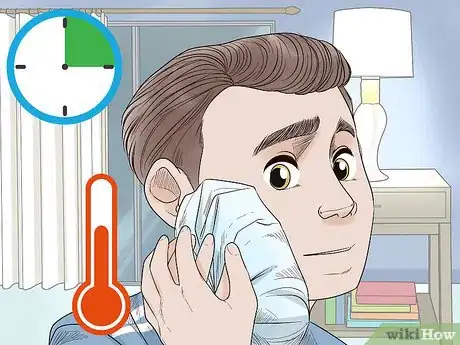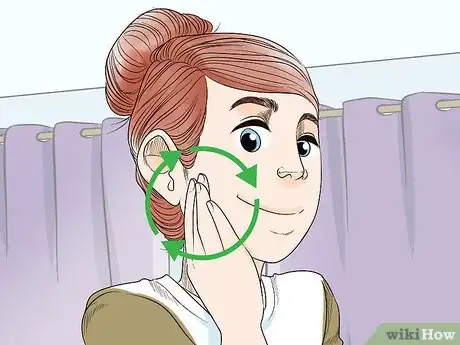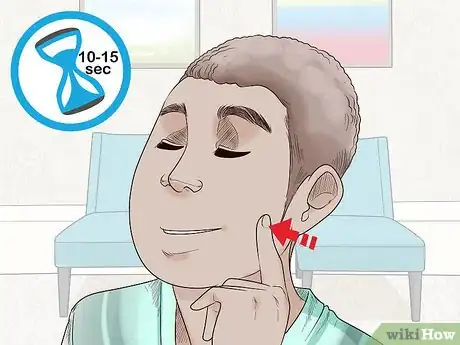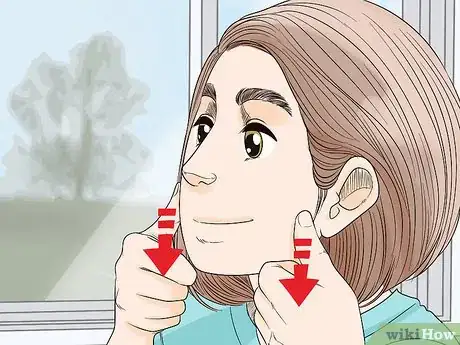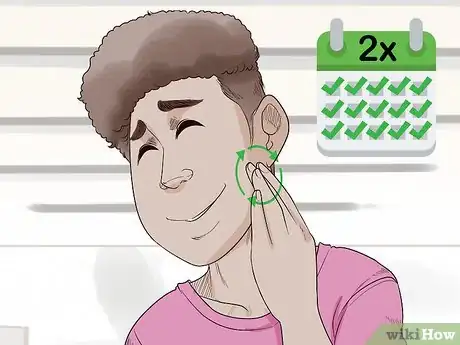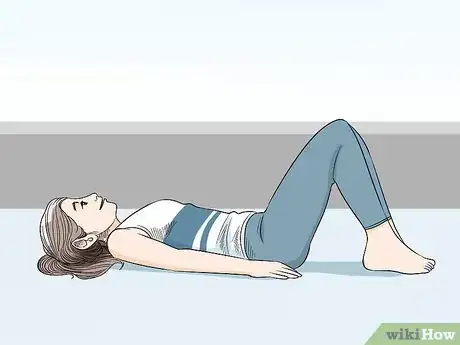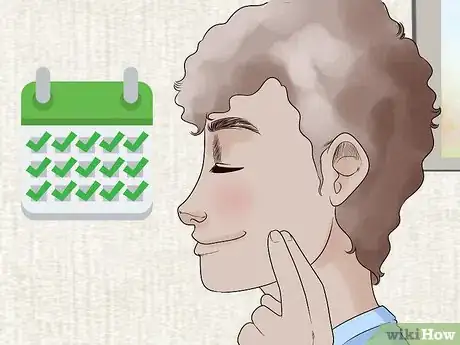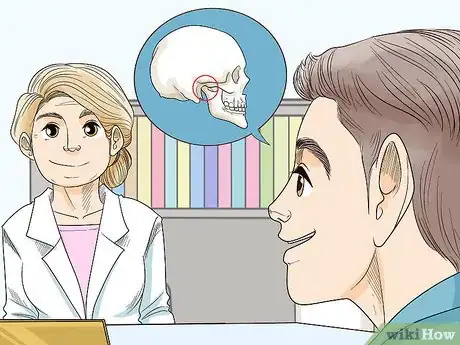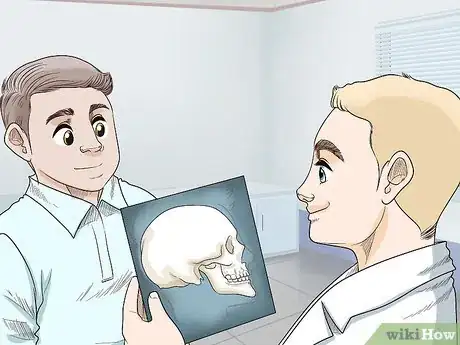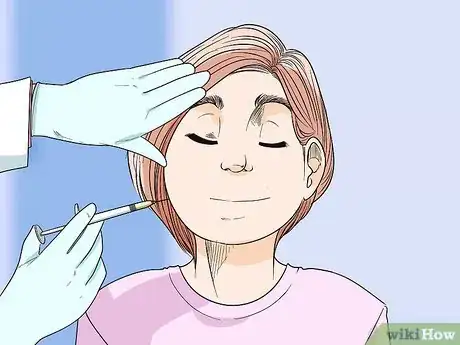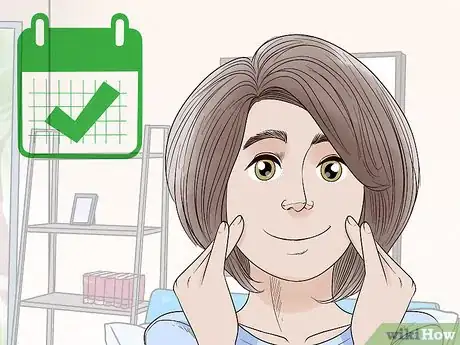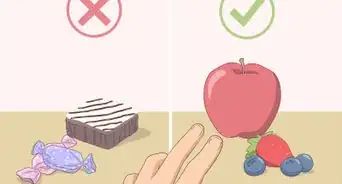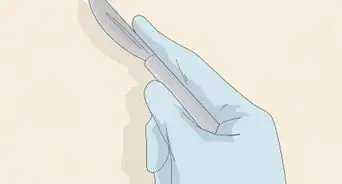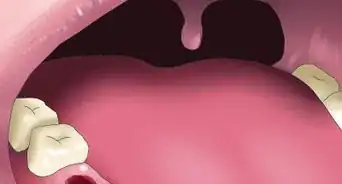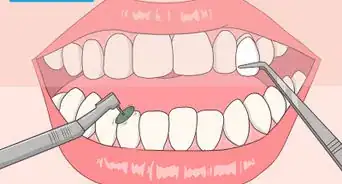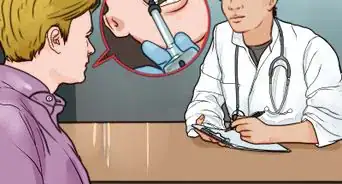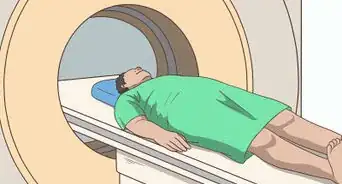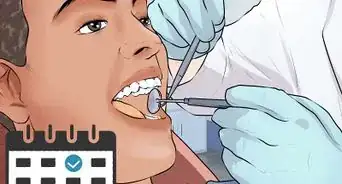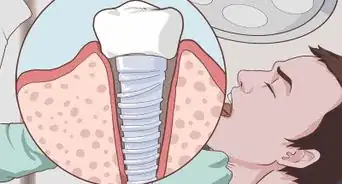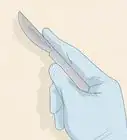This article was medically reviewed by Pradeep Adatrow, DDS, MS. Dr. Pradeep Adatrow is the only board certified Dentist, Periodontist, and Prosthodontist in the southern United States. With over 15 years of experience, Dr. Adatrow specializes in dental implants, TMJ treatments, periodontal plastic surgery, surgical and non-surgical periodontics, bone regeneration, laser treatments, and soft tissue and gum graft procedures. He received a BS in Epidemiology and Biostatistics from the University of Alabama and earned his Doctor of Dental Surgery (DDS) degree from the University of Tennessee College of Dentistry. Dr. Adatrow then completed a three-year postgraduate program in periodontics and implantology at Indiana University and went on to complete another three-year postdoctoral program in advanced prosthodontics from the University of Tennessee. He also serves as a full-time professor and the Director of Surgical Prosthodontics at the University of Tennessee. Dr. Adatrow received the Dean's Junior Faculty Award and the John Diggs Faculty Award, and he was inducted into the Deans Odontological Society. He is board certified by the American Board of Periodontology and is a Fellow of the prestigious International College of Dentistry – a feat that only 10,000 others worldwide can claim.
wikiHow marks an article as reader-approved once it receives enough positive feedback. In this case, several readers have written to tell us that this article was helpful to them, earning it our reader-approved status.
This article has been viewed 402,300 times.
Your jaw is controlled by your temporomandibular joint (TMJ). Your TMJ can become tense or locked due to stress, misalignment, and teeth grinding. A locked jaw is a painful condition that can often cause other problems like headaches and neck or face soreness. Massage your jaw and perform relaxing, destressing jaw exercises to help it release. If your locked jaw becomes severe or painful, see your doctor for treatment. Maintain a healthy jaw by wearing a mouthguard and regulating your stress so your jaw stays relaxed.
Steps
Massaging Your Jaw
-
1Apply a heat pack or a warm compress to your jaw to warm it up. Wrap a heat pack in a towel or soak a clean towel in warm water. Apply the pack or compress to both sides of your jaw. Let it sit for 10-15 minutes to help relax your jaw and reduce any inflammation.[1]
- Always warm up your jaw before you massage it so it is less tense and locked.
- Apply the heat pack or compress several times a day, 10-15 minutes at a time, to help manage your locked jaw.
-
2Knead your jaw with your fingers. Place your fingers on your lower jaw, just below your cheekbones. Knead your jaw gently, moving your fingers back toward your ear. Feel for a flat plane of bone just below your ear. Use 2-3 fingers to gently press on this area and knead the it in a circular motion.
- This will help to warm up the muscles and stimulate the area, which can cause it loosen up.
- Repeat the massage on the other side of your jaw to loosen it as well.
Advertisement -
3Put pressure on your mandible muscle with your index finger. This muscle is located along your jawline on the lower area of your jaw. Apply pressure to this muscle for 5-10 seconds at a time to help release it. If it becomes too painful to do this, apply pressure for shorter amounts of time.
- You should feel your mandible muscle release over time as you apply pressure to it. For some people, this release can help to unlock their jaw or make it feel less tense.
-
4Stretch your TMJ with your thumbs. Place both thumbs on your jaw line, just above the mandible muscle. Put pressure on the muscle as you move your thumbs down your jaw, stretching the muscle away from your upper jaw. This stretch can help to release your TMJ.
- You can also place two fingers on the mandible muscle and two fingers on your upper jaw. Then, move your fingers toward each other until the tips of your fingers sit between both areas. Keep your fingers in place for a few seconds to release the area.
- Ask a friend or partner to help you with this massage if you find it difficult to do on your own.
-
5Use your hands to wiggle your jaw from side to side. Keep your jaw relaxed as you place your hands on either side of your jaw. Gently move it from side to side. Do not tug or press hard on your jaw. Wiggle it slightly until it starts to feel less tense and locked.
- You can also try wiggling your jaw up and down using your hands as a guide. Rub your jaw lightly with your fingers as you move it up and down to help loosen it.
- If your jaw does not move at all or it is very painful when you try to massage it and move it, see your doctor right away. Do not force your jaw to move, as this can damage it further.
-
6Massage your jaw once or twice a day. As your jaw starts to loosen, get in the habit of massaging it once a day. Warm it up first with a heat pack or a warm compress. Over time, it should start to unlock. Eventually, the disc should slide into place and your jaw should regain its normal movement.[2]
- If you do not see improvement in your jaw after 2-3 days, go see your doctor.
Performing Jaw Movement Exercises
-
1Lie down on your back with your knees bent. Start in a relaxed position on a mat or soft floor. Keep your head and neck relaxed on the floor as you lie down.[3]
- You may prop your head up with a thin pillow if you find this more comfortable for your jaw and face.
-
2Draw your attention to your jaw, face, and neck. Breathe in and out a few times as you bring awareness to your face, jaw, and neck. Notice if your face or neck feel tight. Acknowledge that your jaw feels tense and uncomfortable.[4]
-
3Try gently opening and closing your mouth. Inhale as you gently open your mouth a few inches. Only open it to a point where you feel no stress or strain. Then, exhale and close your mouth without letting your teeth touch. Keep your neck and face relaxed as you do this.[5]
- Repeat these movements 5-10 times, inhaling each time you open your mouth and exhaling each time you close your mouth.
- Do not force your mouth to open and close if it starts to tense up or feel tight. Let your jaw rest when needed so you do not damage it further.
-
4Move your jaw to the left and the right. If your jaw does not feel too painful or sore, try shifting it to the left and then to the right. Inhale as you shift it to the left a few inches. Exhale as you bring it back to the center and then inhale as you shift it to the right a few inches.[6]
- Do this 5-10 times on each side.
- If your jaw starts to hurt or tense up, take a break. Do not overexert your jaw, as this can make it worse.
-
5Do jaw movement exercises once a day. Keep your jaw loose and relaxed by doing these exercises once a day.[7] Try doing them at the same time every day so your jaw gets used to the movements.
- If your jaw does not loosen up or becomes more painful, go see your doctor for treatment.
Seeing Your Doctor for Treatment
-
1Go to your doctor if your jaw does not unlock with home care. If your jaw does not loosen up with massage or jaw movement exercises, see your doctor for guidance. Your doctor can help to determine the cause of your locked jaw and provide options to unlock it.
- Your doctor may prescribe medicine to treat your locked jaw or TMJ, such as NSAIDs like Aspirin or ibuprofen, pain relievers, muscle relaxers, anti-anxiety medicine, or a low-dose anti-depressant. Talk to your doctor before you add any medications, even if they are over-the-counter.
-
2See your doctor if you experience headaches or neck pain due to locked jaw. In some cases, a locked jaw can become so severe it causes headaches and neck pain, where your neck feels strained or swollen. You may also develop soreness and tension in your face. Speak to your doctor if you experience these symptoms so they do not get worse.
-
3Allow your doctor to examine your jaw and run tests. Your doctor will start by gently examining your jaw area to determine how severe your condition is. They may also order X-rays of your jaw to get a better idea of the damage or misalignment of your jaw bone.[8]
- In some cases, your doctor will get an MRI done of your jaw to get a closer look at your TMJ.
-
4Let your doctor shift your jaw back into place. Your doctor will give you a local anesthesia or a muscle relaxant so you do not tense up your jaw. They will then pull your lower jaw down and guide the disc in your jaw back into place.
- This procedure can be done in your doctor’s office and is not usually painful.
- You will need to maintain a liquid diet for several days after the procedure to allow your jaw to recover.
-
5Get Botox injections to loosen your jaw. Botox can help to relax the muscles in your jaw and relieve any stress on your TMJ. Your doctor can give you Botox injections directly into your jaw muscles to relax them and help your jaw unlock.[9]
- Botox injections in your jaw muscles should only be used occasionally, as too much Botox can cause your jaw muscles to weaken.
- Keep in mind your health insurance may not cover the use of Botox injections, as they may be considered a cosmetic treatment. Check with your insurance provider for more information.
-
6Consider surgery if your jaw continues to lock. If your jaw locks on a regular basis, your doctor may suggest surgery on your jaw joint to ensure it stays in place. This surgery is considered invasive and will require substantial recovery time where you must maintain a liquid diet and keep your mouth wired shut so it can heal. Your doctor will outline the risks and recovery time for the surgery before you get it done.[10]
- In most cases, doing jaw massage and exercises, as well using a mouthguard, is enough to prevent locked jaw from returning.
Maintaining a Healthy Jaw
-
1Wear a mouthguard when you sleep. This plastic mouthpiece will cover your teeth and prevent you from grinding your teeth or clenching your jaw. Your doctor will create a custom mouthguard for you to wear at night while you sleep. It will be molded to fit your teeth and bite, making it more comfortable than a generic mouthguard you buy at the store.[11]
- Make sure the mouthguard fits you well and that you wear it every night. Regular use of a mouthguard can prevent lockjaw and keep your jaw healthy.
-
2Avoid hard, crunchy, or sticky foods. Stay away from tough meats like steak and raw vegetables like carrots or broccoli.[12] Do not have hard or chewy candies, as they can put stress on your jaw. Avoid chewing on ice cubes, as they can be hard on your teeth and jaw.
- When you eat foods, make sure you do not open your mouth too wide, as this can cause the disc in your jaw to shift. Chew your food slowly and carefully so you do not bite down too hard or shift your jaw out of place.
-
3Do jaw massages and exercises regularly.[13] Get in the habit of massaging your jaw before bed or in the morning so it stays relaxed and loose. Perform jaw exercises once a day or several time a week so your jaw does not become tense or tight.
-
4Keep your stress levels manageable.[14] Stress and anxiety can cause you to clench or tighten your jaw, which can lead to lockjaw. Stay active by exercising once a day or going for a relaxing run or walk so you have an outlet for your stress. Do a calming activity like painting, knitting, or drawing on a regular basis so you can stay relaxed.
- You can also spend time with friends and family to de-stress so you stay healthy and relaxed.
Expert Q&A
Did you know you can get expert answers for this article?
Unlock expert answers by supporting wikiHow
-
QuestionWhat are common triggers for TMJ?
 Pradeep Adatrow, DDS, MSDr. Pradeep Adatrow is the only board certified Dentist, Periodontist, and Prosthodontist in the southern United States. With over 15 years of experience, Dr. Adatrow specializes in dental implants, TMJ treatments, periodontal plastic surgery, surgical and non-surgical periodontics, bone regeneration, laser treatments, and soft tissue and gum graft procedures. He received a BS in Epidemiology and Biostatistics from the University of Alabama and earned his Doctor of Dental Surgery (DDS) degree from the University of Tennessee College of Dentistry. Dr. Adatrow then completed a three-year postgraduate program in periodontics and implantology at Indiana University and went on to complete another three-year postdoctoral program in advanced prosthodontics from the University of Tennessee. He also serves as a full-time professor and the Director of Surgical Prosthodontics at the University of Tennessee. Dr. Adatrow received the Dean's Junior Faculty Award and the John Diggs Faculty Award, and he was inducted into the Deans Odontological Society. He is board certified by the American Board of Periodontology and is a Fellow of the prestigious International College of Dentistry – a feat that only 10,000 others worldwide can claim.
Pradeep Adatrow, DDS, MSDr. Pradeep Adatrow is the only board certified Dentist, Periodontist, and Prosthodontist in the southern United States. With over 15 years of experience, Dr. Adatrow specializes in dental implants, TMJ treatments, periodontal plastic surgery, surgical and non-surgical periodontics, bone regeneration, laser treatments, and soft tissue and gum graft procedures. He received a BS in Epidemiology and Biostatistics from the University of Alabama and earned his Doctor of Dental Surgery (DDS) degree from the University of Tennessee College of Dentistry. Dr. Adatrow then completed a three-year postgraduate program in periodontics and implantology at Indiana University and went on to complete another three-year postdoctoral program in advanced prosthodontics from the University of Tennessee. He also serves as a full-time professor and the Director of Surgical Prosthodontics at the University of Tennessee. Dr. Adatrow received the Dean's Junior Faculty Award and the John Diggs Faculty Award, and he was inducted into the Deans Odontological Society. He is board certified by the American Board of Periodontology and is a Fellow of the prestigious International College of Dentistry – a feat that only 10,000 others worldwide can claim.
Board Certified Dentist & Oral Surgeon Any action that you perform with your mouth that is not related to eating, drinking, or speaking is considered a parafunction and can be bad for your dental and TMJ health. These would include biting fingernails, constant chewing of gum, eating hard or chewy food, and voluntary or involuntary grinding of the teeth.
Any action that you perform with your mouth that is not related to eating, drinking, or speaking is considered a parafunction and can be bad for your dental and TMJ health. These would include biting fingernails, constant chewing of gum, eating hard or chewy food, and voluntary or involuntary grinding of the teeth.
References
- ↑ https://www.webmd.com/oral-health/qa/how-should-i-apply-moist-heat-or-cold-packs-to-treat-temporomandibular-disorders-tmd
- ↑ https://www.nhs.uk/conditions/temporomandibular-disorder-tmd/
- ↑ https://www.linkedin.com/pulse/unlock-your-jaw-heal-pain-cheryl-ilov-pt-gcfp/
- ↑ https://www.linkedin.com/pulse/unlock-your-jaw-heal-pain-cheryl-ilov-pt-gcfp/
- ↑ https://www.linkedin.com/pulse/unlock-your-jaw-heal-pain-cheryl-ilov-pt-gcfp/
- ↑ https://www.linkedin.com/pulse/unlock-your-jaw-heal-pain-cheryl-ilov-pt-gcfp/
- ↑ Pradeep Adatrow, DDS, MS. Board Certified Dentist & Oral Surgeon. Expert Interview. 30 September 2020.
- ↑ https://www.mayoclinic.org/diseases-conditions/tmj/diagnosis-treatment/drc-20350945
- ↑ https://www.health.harvard.edu/blog/unlocking-the-lock-jaw-temporomandibular-joint-tmj-dysfunction-2017022211146
- ↑ https://www.mayoclinic.org/diseases-conditions/tmj/diagnosis-treatment/drc-20350945
- ↑ https://www.health.harvard.edu/blog/unlocking-the-lock-jaw-temporomandibular-joint-tmj-dysfunction-2017022211146
- ↑ Pradeep Adatrow, DDS, MS. Board Certified Dentist & Oral Surgeon. Expert Interview. 30 September 2020.
- ↑ Pradeep Adatrow, DDS, MS. Board Certified Dentist & Oral Surgeon. Expert Interview. 30 September 2020.
- ↑ Pradeep Adatrow, DDS, MS. Board Certified Dentist & Oral Surgeon. Expert Interview. 30 September 2020.
About This Article
To unlock your jaw, place your fingers on your lower jaw, and knead gently in a circular motion to warm up the muscles and cause them to loosen up. Alternatively, use your hands to gently wiggle your jaw from side to side. You can also try relaxing your jaw with a warm compress by soaking a towel in warm water and applying it to your jaw for 10 to 15 minutes. If your jaw does not loosen with any of these methods, see a doctor right away for further treatment. For more advice from our Medical reviewer, including how to maintain a healthy jaw with jaw movement exercises, keep reading.
